Plant Classification
Plant Traits and Terminology
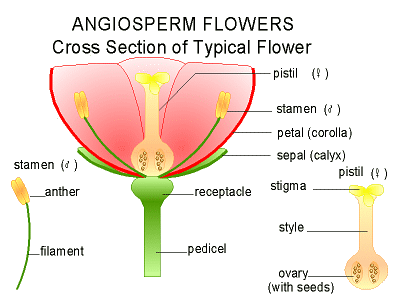 As we go on field hikes in Biology Lab, you will be learning to identify
many of the local plants and animals. For many of the plants we find, we
will also discuss in what plant family those plants are classified. You
will be expected to sight-identify these plants to family, based on knowing
and recognizing key characteristics of the families to which they belong.
You may also be expected to sight-identify new, unfamiliar plants to family
based on their characteristics.
As we go on field hikes in Biology Lab, you will be learning to identify
many of the local plants and animals. For many of the plants we find, we
will also discuss in what plant family those plants are classified. You
will be expected to sight-identify these plants to family, based on knowing
and recognizing key characteristics of the families to which they belong.
You may also be expected to sight-identify new, unfamiliar plants to family
based on their characteristics.
To a biologist, the words “plant” and “flower” have very
specific and
different meanings. A flower is a specialized reproductive structure
which develops on plants in the
Angiospermae.
In most cases, it is technically
incorrect to say that you have planted “flowers” in your garden (unless you
buried the wilted, cut roses a friend gave you a month ago), and in general,
the result of that would be compost. However, to say that you put “plants”
into your garden so you could enjoy the flowers they produce is an appropriate
statement. Note that both maple trees and marigolds are plants, and
both produce flowers. Throughout this discussion, the word “flower” will be
used to mean a flower, not a plant.
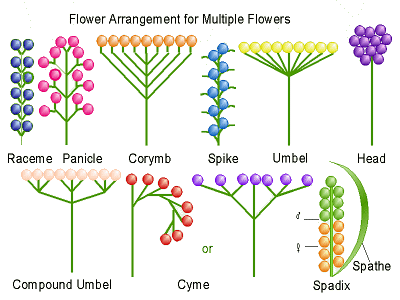 Plants are typically grouped into families based on similarities in their
structures. The type(s) and organization of the flower parts are often key
traits by which plant families may be determined. Thus,
botanists,
have come up with
a scheme for representing the flower structure of the various families.
Botanists represent the parts of flowers and arrangement of those parts
using the following notation.
Plants are typically grouped into families based on similarities in their
structures. The type(s) and organization of the flower parts are often key
traits by which plant families may be determined. Thus,
botanists,
have come up with
a scheme for representing the flower structure of the various families.
Botanists represent the parts of flowers and arrangement of those parts
using the following notation.
In this notation, a horizontal line is used to represent the
receptacle,
thereby indicating which parts are attached above or below
the receptacle. The area of the stem just below the receptacle is called the
pedicel.
The following symbols are used to represent other flower parts.
- Ca = calyx of sepals
- Co = corolla of petals
- T = Occasionally when the sepals and petals
are very similar, (like in lilies and tulips), they are collectively called
tepals.
- Coz = irregular or
zygomorphic
corolla
- S =
stamen
consisting of anther and filament
- P =
pistil
consisting of stigma, style, and ovaries, with the terms carpels, locules,
ovules, and/or placenta referring to parts of the ovary
- ∞ = many, possibly variable number of
parts
- x = few, possibly variable number of
parts
 = parts are united
= parts are united  = parts are united below (like stamens with united filaments, but not
anthers)
= parts are united below (like stamens with united filaments, but not
anthers)  = parts are united above (like stamens with united anthers, but not
filaments)
= parts are united above (like stamens with united anthers, but not
filaments) - 4+4 = organs in two sets (S4+2
would indicate two sets of stamens with 4 and 2 stamens in those sets)
-
= stamens attached to corolla, referred to as
epipetalous
-
= inferior ovary and epipetalous stamens
 These symbols may be combined, as needed, to represent the structure of a
given flower. For example, the formula to the right means that in this
particular flower, there are five free sepals, five
united petals, five free, epipetalous stamens, an inferior ovary with two
united carpels, and the type of fruit is a capsule. Here, then, are
descriptions of some of the main families of plants.
These symbols may be combined, as needed, to represent the structure of a
given flower. For example, the formula to the right means that in this
particular flower, there are five free sepals, five
united petals, five free, epipetalous stamens, an inferior ovary with two
united carpels, and the type of fruit is a capsule. Here, then, are
descriptions of some of the main families of plants.
Selected Plant Families
- Monocots:
- Corollifera: These have tepals and often bulbs, corms, and/or
rhizomes.
- Araceae
- The type of inflorescence is a
spathe
and
spadix.
- Liliaceae
 These have six stamens, a superior
ovary, and regular flowers. The
three petals + three sepals look
very similar and so are called
“tepals.”
These have six stamens, a superior
ovary, and regular flowers. The
three petals + three sepals look
very similar and so are called
“tepals.”
- Glumiflorae: These have no petals or sepals as such, but may
often these modified into scales, bristles, etc. Runners are common,
as well as rhizomes in perennial species.
- Gramineae
- Each leaf is divided into a
blade and a sheath.
The sheath is usually open on the
opposite side. The stems are
cylindrical or flattened, and
frequently hollow. There are usually
two rows (ranks) of leaves.
- Cyperaceae
- The sheathes are closed (united
on the other side). The stems
are usually triangular, and leaves
are three-ranked. The stems
frequently contain pith and are not
hollow.
- Dicots:
- Polypetalae: These exhibit the primitive condition of having
non-united petals.
- Hypogynous:
The flower parts are located under the ovary, or as a
botanist would say, each flower has a superior ovary.
- Apocarpous (apo = off, from, away from,
detached; carpo = fruit): These plants have
several separate, un-united pistils in each flower.
- Ranunculaceae
 These plants are generally herbaceous,
and have watery juice. The
sepals are sometimes absent or
similar to the petals, so often all
called tepals instead. Sometimes
there is an indefinite number of
sepals. A spiral arrangement of
flower parts is characteristic.
These plants are generally herbaceous,
and have watery juice. The
sepals are sometimes absent or
similar to the petals, so often all
called tepals instead. Sometimes
there is an indefinite number of
sepals. A spiral arrangement of
flower parts is characteristic.
- Syncarpous (syn = with, together): These
plants have flowers with two or more pistils united
together.
- Papaveraceae
 These plants are generally herbaceous.
Almost all “bleed” milky or
colored juice when injured.
There are two to three sepals
which usually are deciduous (fall off
as the flower opens). The petals are
crumpled in the bud. The seed
capsule often has an apical lobed
disc.
These plants are generally herbaceous.
Almost all “bleed” milky or
colored juice when injured.
There are two to three sepals
which usually are deciduous (fall off
as the flower opens). The petals are
crumpled in the bud. The seed
capsule often has an apical lobed
disc. - Fumariaceae
(some botanists consider this a subfamily
within the Papaveraceae)
 These plants are herbaceous. Some
species are annuals while others are
perennial. They typically bear bi-
or tripinnately, finely divided
leaves which are smooth and
glaucous.
The flowers usually have one or two
sac-like petals including a nectary
spur.
These plants are herbaceous. Some
species are annuals while others are
perennial. They typically bear bi-
or tripinnately, finely divided
leaves which are smooth and
glaucous.
The flowers usually have one or two
sac-like petals including a nectary
spur. - Cruciferae
- Co4S6
These have flower parts in sets of
four. There are four petals.
The stamens are
diadelphous:
the flowers have six stamens
composed of a set of four plus a set
of two. The type of fruit is
called a silicle or silique. The
inflorescence is a raceme. Many of
these plants are edible and usually
have a characteristic taste due to
the presence of organic sulfur
compounds.
- Caryophyllaceae
- The leaves of these plants are
opposite or whorled, and typically
there are swollen nodes where
the leaves join the stem. Most
species are herbaceous. The petals
are frequently notched (“pinked,”
like pinking shears). Many have
united sepals with un-united petals
inside the tube formed by the
sepals. Many have two sets of
stamens for a total of ten. The
inflorescence is a cyme.
- Violaceae
 Most of these plants are herbaceous
perennials. The leaves are simple,
basal or alternate, and often
cordate (cordis = heart:
heart-shaped). The irregular
flower often have a nectary spur
(petal). In the formula, the “1:3”
in a circle means a one-celled,
tricarpelate (tri =
three) pistil (the pistil originated
from three fused carpels, but there
is only one, not three chambers, and
the seeds are attached in three
batches around the edges).
Most of these plants are herbaceous
perennials. The leaves are simple,
basal or alternate, and often
cordate (cordis = heart:
heart-shaped). The irregular
flower often have a nectary spur
(petal). In the formula, the “1:3”
in a circle means a one-celled,
tricarpelate (tri =
three) pistil (the pistil originated
from three fused carpels, but there
is only one, not three chambers, and
the seeds are attached in three
batches around the edges).
- Perigynous:
Plants in these families possess an
hypanthium,
an outgrowth or enlargement of the receptacle which surrounds
the ovary. The ovary is actually superior, but may
appear to be inferior because of the hypanthium.
- Leguminosae
 There are both herbaceous and woody
species. The irregular flowers are
said to be
papilionaceous
in shape. The fruit is a legume
(some are modified). Plants bear
alternate leaves with stipules.
The roots are frequently deep, and
many have nodules containing
nitrogen-fixing bacteria). While the
fruits of many species are edible,
others may have poisonous beans.
There are both herbaceous and woody
species. The irregular flowers are
said to be
papilionaceous
in shape. The fruit is a legume
(some are modified). Plants bear
alternate leaves with stipules.
The roots are frequently deep, and
many have nodules containing
nitrogen-fixing bacteria). While the
fruits of many species are edible,
others may have poisonous beans. 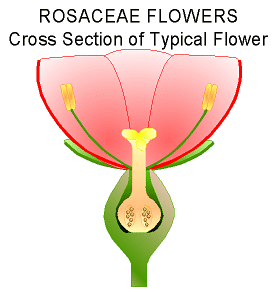 Rosaceae
Rosaceae These flowers possess an
hypanthium
(the fruit in an apple, which has
grown around the ovary). These
species are mostly perennial. Some
are herbaceous while others are
shrubs or trees. The leaves are
alternate with
stipules
which sometimes fall off. The
five-parted, regular flowers contain
numerous stamens. It can be
hard to tell Rosaceae from
Ranunculaceae. While the hypanthium
may be hard to see in some Rosaceae,
in others it may be large enough to
make the ovary appear to be
inferior. However, it is not present
in Ranunculaceae (which should have
obviously superior ovaries).
These flowers possess an
hypanthium
(the fruit in an apple, which has
grown around the ovary). These
species are mostly perennial. Some
are herbaceous while others are
shrubs or trees. The leaves are
alternate with
stipules
which sometimes fall off. The
five-parted, regular flowers contain
numerous stamens. It can be
hard to tell Rosaceae from
Ranunculaceae. While the hypanthium
may be hard to see in some Rosaceae,
in others it may be large enough to
make the ovary appear to be
inferior. However, it is not present
in Ranunculaceae (which should have
obviously superior ovaries).
- Epigynous:
The flower parts are located above the ovary, or as a botanist would say, the ovary is inferior.
- Umbelliferae
- Most species are herbaceous. The
leaves are alternate, mostly
pinnately-compound, and finely-divided.
The leaf petioles sheath the
stem. The inflorescence is
an umbel. Some have reduced
umbels that resemble heads. Many
have a distinctive odor or flavor,
and while some are edible or used as
seasonings, others are poisonous.
- Apetalae: The corolla is absent.
- Floriferae: The sepals may or may not be colored and look
like a false corolla.
- Polygonaceae
- These are mostly herbaceous
species. At the base of each leaf,
specially modified stipules
sheath the stem and the nodes
are frequently swollen into knots.
The flowers are small.
- Sympetalae: The petals are at least partially united in some way.
- Hypogynous: These have a superior ovary with the other flower parts below the ovary.
- Asclepiadaceae
- These perennial herbs have milky
juice. The leaves are opposite
or whorled. In many species, the
inflorescence is an umbel, but in a
few others, may be a cyme. The
flowers usually have a crown or
corona, and the petals are reflexed.
Often, only one flower per umbel
produces fruit. Many have a strong,
pleasant odor. The pollen is clustered
in pollinia (sing. = pollinium, masses
of pollen grains), rather than as
single grains.
- Oleaceae
- Co4S2
While these flowers also have four
petals, they can be distinguished from
the Cruciferae by the presence of only
two, epipetalous stamens and
a corolla which is united at the base.
Many are woody plants.
-
Labiatae
 Most species are herbaceous, and have
square stems, opposite (or rarely,
whorled) leaves, and a minty odor. There
are two carpels per pistil, and these are
deeply lobed because there are four nutlets
per fruit (resulting in a four-lobed ovary
as indicated by the “puffy” circle in the
formula). They have a
bilabiate corolla
and two or four stamens.
Most species are herbaceous, and have
square stems, opposite (or rarely,
whorled) leaves, and a minty odor. There
are two carpels per pistil, and these are
deeply lobed because there are four nutlets
per fruit (resulting in a four-lobed ovary
as indicated by the “puffy” circle in the
formula). They have a
bilabiate corolla
and two or four stamens. - Scrophulariaceae
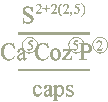 While these also have a
bilabiate corolla, the stem
is not square, nor is there a
minty odor. Most are herbaceous
perennials. The leaves are opposite,
exstipulate (having no stipules),
and mostly simple. There are two carpels
in the pistil, and the carpels are not
deeply lobed. The fruit is a
capsule.
While these also have a
bilabiate corolla, the stem
is not square, nor is there a
minty odor. Most are herbaceous
perennials. The leaves are opposite,
exstipulate (having no stipules),
and mostly simple. There are two carpels
in the pistil, and the carpels are not
deeply lobed. The fruit is a
capsule. - Solanaceae
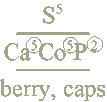 These herbaceous plants bear five-parted,
regular flowers and have alternate leaves.
The fruit is a pod or berry with numerous
seeds. Most have a characteristic rank
odor and contain many toxic chemicals. In
the genus
Solanum,
the stamens are touching at the tips
of anthers (the anthers come together,
but are not united, giving the
appearance of a “bird beak”) and
dehisce by pores in the tips of the
anthers. Some species have a
totally-united, trumpet-like corolla,
while others have the corolla united
only at the base, frequently with
reflexed petals.
These herbaceous plants bear five-parted,
regular flowers and have alternate leaves.
The fruit is a pod or berry with numerous
seeds. Most have a characteristic rank
odor and contain many toxic chemicals. In
the genus
Solanum,
the stamens are touching at the tips
of anthers (the anthers come together,
but are not united, giving the
appearance of a “bird beak”) and
dehisce by pores in the tips of the
anthers. Some species have a
totally-united, trumpet-like corolla,
while others have the corolla united
only at the base, frequently with
reflexed petals.
- Epigynous: These have an inferior ovary with the other
flower parts above the ovary.
- Lobeliaceae
(some botanists consider this a subfamily within
the
Campanulaceae)
 No information on Lobeliaceae as such
was given in the notes I was consulting.
For Campanulaceae, the stamens generally
are not epipetalous and frequently have
their bases enlarged. Campanulaceae
plants are herbaceous with milky juice and
alternate leaves. The formula given is
that for Campanulaceae.
No information on Lobeliaceae as such
was given in the notes I was consulting.
For Campanulaceae, the stamens generally
are not epipetalous and frequently have
their bases enlarged. Campanulaceae
plants are herbaceous with milky juice and
alternate leaves. The formula given is
that for Campanulaceae. - Compositae
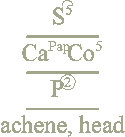
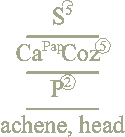 The inflorescence
is a head with an involucre of
bracts (specially-modified
leaves) subtending it. The fruit is
called an
achene.
The anthers are united cylindrically,
and the stigmas and style grow through
them. The stamens are epipetalous.
The calyx is modified into a
pappus
for dissemination. The heads of many
species contain both ray
(ligulate)
and disc (tubular) flowers. Disc
flowers are tubular and regular,
while ray or ligulate flowers
have a strap-like, fused corolla. The
latter are irregular flowers with
five, united petals. Dandelions have
all ligulate flower, while thistles
have only tubular flowers, and daisies
have a ring of ligulate flowers
surrounding a number of disc flowers.
In many species with a border of
ligulate flowers surrounding a number
of disc flowers, the ligulate flowers
are sterile and serve the purpose of
attracting
pollinators.
Some species also have chaff,
modified bracts that may subtend each
of the disk flowers.
The inflorescence
is a head with an involucre of
bracts (specially-modified
leaves) subtending it. The fruit is
called an
achene.
The anthers are united cylindrically,
and the stigmas and style grow through
them. The stamens are epipetalous.
The calyx is modified into a
pappus
for dissemination. The heads of many
species contain both ray
(ligulate)
and disc (tubular) flowers. Disc
flowers are tubular and regular,
while ray or ligulate flowers
have a strap-like, fused corolla. The
latter are irregular flowers with
five, united petals. Dandelions have
all ligulate flower, while thistles
have only tubular flowers, and daisies
have a ring of ligulate flowers
surrounding a number of disc flowers.
In many species with a border of
ligulate flowers surrounding a number
of disc flowers, the ligulate flowers
are sterile and serve the purpose of
attracting
pollinators.
Some species also have chaff,
modified bracts that may subtend each
of the disk flowers.
- A couple of non-Angiosperms:
- Pinaceae
- The leaves are modified as needles.
The seeds form on the surface of a cone
(= naked seeds), not in an ovary. There
are no flowers.
- Polypodiaceae
- There are no flowers nor seeds,
and reproduction is accomplished (in
part) by the release of spores
from chambers called
sporangia
on the backs of specially-modified
fertile leaves.
Some Further Terminology:
- Complete vs. Incomplete: A complete flower has all four layers of
parts while an incomplete flower lacks one or more of the layers.
- Perfect vs. Imperfect: A perfect flower has both sexes while an
incomplete flower lacks one or the other. If a species has imperfect flowers,
but both male and female flowers are on the same plant, that species is said
to be
monoecious.
If the male and female flowers are on separate, male and female plants, that
species is said to be
dioecious.
- Regular vs. Irregular: A regular flower is radially symmetrical
while an irregular flower has bilateral symmetry, and is also known as a
zygomorphic
flower.
- An
hypogynous
flower has a superior ovary and no hypanthium.
- A
perigynous
flower has an
hypanthium
around the ovary. The receptacle grows out to form a disc or cup around the
ovary with the calyx and corolla at its edges. Thus, while the ovary may
appear to be inferior, it really is superior.
- An
epigynous
flower has an inferior ovary.
- If all flower parts are attached to the receptacle and are free, the
flower is termed
polypetalous,
and this is the primitive state.
- The more usual (and advanced) case is when the petals are united in some
way, in which case the flower is termed
sympetalous.
- If the stamens arise from out of the petal tissue, the flower is termed
epipetalous.
- The pistil may be simple or compound, depending on the number of carpels
which are united to form it. “Placentation” refers to where and/or how the
seeds are attached.
Copyright © 1998 by J. Stein Carter. All rights reserved.
Chickadee photograph Copyright © by David B. Fankhauser
This page has been accessed  times since 25 Dec 2012.
times since 25 Dec 2012.
 As we go on field hikes in Biology Lab, you will be learning to identify
many of the local plants and animals. For many of the plants we find, we
will also discuss in what plant family those plants are classified. You
will be expected to sight-identify these plants to family, based on knowing
and recognizing key characteristics of the families to which they belong.
You may also be expected to sight-identify new, unfamiliar plants to family
based on their characteristics.
As we go on field hikes in Biology Lab, you will be learning to identify
many of the local plants and animals. For many of the plants we find, we
will also discuss in what plant family those plants are classified. You
will be expected to sight-identify these plants to family, based on knowing
and recognizing key characteristics of the families to which they belong.
You may also be expected to sight-identify new, unfamiliar plants to family
based on their characteristics.
 Plants are typically grouped into families based on similarities in their
structures. The type(s) and organization of the flower parts are often key
traits by which plant families may be determined. Thus,
Plants are typically grouped into families based on similarities in their
structures. The type(s) and organization of the flower parts are often key
traits by which plant families may be determined. Thus,
 These symbols may be combined, as needed, to represent the structure of a
given flower. For example, the formula to the right means that in this
particular flower, there are five free sepals, five
united petals, five free, epipetalous stamens, an inferior ovary with two
united carpels, and the type of fruit is a capsule. Here, then, are
descriptions of some of the main families of plants.
These symbols may be combined, as needed, to represent the structure of a
given flower. For example, the formula to the right means that in this
particular flower, there are five free sepals, five
united petals, five free, epipetalous stamens, an inferior ovary with two
united carpels, and the type of fruit is a capsule. Here, then, are
descriptions of some of the main families of plants.
 These have six stamens, a superior
ovary, and regular flowers. The
three petals + three sepals look
very similar and so are called
“tepals.”
These have six stamens, a superior
ovary, and regular flowers. The
three petals + three sepals look
very similar and so are called
“tepals.”  These plants are generally herbaceous,
and have watery juice. The
sepals are sometimes absent or
similar to the petals, so often all
called tepals instead. Sometimes
there is an indefinite number of
sepals. A spiral arrangement of
flower parts is characteristic.
These plants are generally herbaceous,
and have watery juice. The
sepals are sometimes absent or
similar to the petals, so often all
called tepals instead. Sometimes
there is an indefinite number of
sepals. A spiral arrangement of
flower parts is characteristic.  These plants are generally herbaceous.
Almost all “bleed” milky or
colored juice when injured.
There are two to three sepals
which usually are deciduous (fall off
as the flower opens). The petals are
crumpled in the bud. The seed
capsule often has an apical lobed
disc.
These plants are generally herbaceous.
Almost all “bleed” milky or
colored juice when injured.
There are two to three sepals
which usually are deciduous (fall off
as the flower opens). The petals are
crumpled in the bud. The seed
capsule often has an apical lobed
disc.  These plants are herbaceous. Some
species are annuals while others are
perennial. They typically bear bi-
or tripinnately, finely divided
leaves which are smooth and
These plants are herbaceous. Some
species are annuals while others are
perennial. They typically bear bi-
or tripinnately, finely divided
leaves which are smooth and
 Most of these plants are herbaceous
perennials. The leaves are simple,
basal or alternate, and often
cordate (cordis = heart:
heart-shaped). The irregular
flower often have a nectary spur
(petal). In the formula, the “1:3”
in a circle means a one-celled,
tricarpelate (tri =
three) pistil (the pistil originated
from three fused carpels, but there
is only one, not three chambers, and
the seeds are attached in three
batches around the edges).
Most of these plants are herbaceous
perennials. The leaves are simple,
basal or alternate, and often
cordate (cordis = heart:
heart-shaped). The irregular
flower often have a nectary spur
(petal). In the formula, the “1:3”
in a circle means a one-celled,
tricarpelate (tri =
three) pistil (the pistil originated
from three fused carpels, but there
is only one, not three chambers, and
the seeds are attached in three
batches around the edges).  There are both herbaceous and woody
species. The irregular flowers are
said to be
There are both herbaceous and woody
species. The irregular flowers are
said to be

 These flowers possess an
These flowers possess an
 Most species are herbaceous, and have
square stems, opposite (or rarely,
whorled) leaves, and a minty odor. There
are two carpels per pistil, and these are
deeply lobed because there are four nutlets
per fruit (resulting in a four-lobed ovary
as indicated by the “puffy” circle in the
formula). They have a
Most species are herbaceous, and have
square stems, opposite (or rarely,
whorled) leaves, and a minty odor. There
are two carpels per pistil, and these are
deeply lobed because there are four nutlets
per fruit (resulting in a four-lobed ovary
as indicated by the “puffy” circle in the
formula). They have a
 While these also have a
bilabiate corolla, the stem
is not square, nor is there a
minty odor. Most are herbaceous
perennials. The leaves are opposite,
exstipulate (having no stipules),
and mostly simple. There are two carpels
in the pistil, and the carpels are not
deeply lobed. The fruit is a
capsule.
While these also have a
bilabiate corolla, the stem
is not square, nor is there a
minty odor. Most are herbaceous
perennials. The leaves are opposite,
exstipulate (having no stipules),
and mostly simple. There are two carpels
in the pistil, and the carpels are not
deeply lobed. The fruit is a
capsule.  These herbaceous plants bear five-parted,
regular flowers and have alternate leaves.
The fruit is a pod or berry with numerous
seeds. Most have a characteristic rank
odor and contain many toxic chemicals. In
the genus
These herbaceous plants bear five-parted,
regular flowers and have alternate leaves.
The fruit is a pod or berry with numerous
seeds. Most have a characteristic rank
odor and contain many toxic chemicals. In
the genus
 No information on Lobeliaceae as such
was given in the notes I was consulting.
For Campanulaceae, the stamens generally
are not epipetalous and frequently have
their bases enlarged. Campanulaceae
plants are herbaceous with milky juice and
alternate leaves. The formula given is
that for Campanulaceae.
No information on Lobeliaceae as such
was given in the notes I was consulting.
For Campanulaceae, the stamens generally
are not epipetalous and frequently have
their bases enlarged. Campanulaceae
plants are herbaceous with milky juice and
alternate leaves. The formula given is
that for Campanulaceae. 
 The
The